Review: LEGO 42156 Peugeot 9X8 24H LeMans Hybrid Hypercar
 1
1

Lately, it seems like there’s nothing the LEGO Technic theme likes more than licensed vehicles, with an increasing number of them appearing every year.
To coincide with the 24 Hours of Le Mans 2023, which celebrates the 100th anniversary of the first 24 hours race back in 1923, LEGO Technic have collaborated with Peugeot to mark the French carmaker’s return to the endurance race with the Peugeot 9X8.
42156 Peugeot 9X8 24H Le Mans Hybrid Hypercar joins a lineup of 1:10 Technic cars, and it’s nice to see more Technic vehicles hailing from the world of endurance racing.
With its novel source material and striking design elements, guest reviewer and automotive expert Vaderfan explores whether the Peugeot 9X8 is worth the US$199.99 asking price, or if you should look elsewhere within the competitive field of LEGO Technic sets.
Special thanks to LEGO for sending this set over for a review
42156 Peugeot 9X8 24H LeMans Hybrid Hypercar Set Details

Set Number: 42156
Set Name: Peugeot 9X8 24H LeMans Hybrid Hypercar
Pieces: 1775
Retail Price: US$199.99 / AU$299.99 / £169.99 / €199.99 / CAD$279.99
Theme: Technic
Release Date: 1 May 2023
Unboxing

The box has the usual all-black 18+ box design, with a nice lime green border at the bottom with Technic elements. The car is displayed at a 3/4 angle, with logos for LEGO, Peugeot, and the 24h of LeMans prominently captured.

The back of the box shows off a photo and some information about the real car, but interestingly doesn’t showcase any of the set’s play features. There’s also a graphic showing the track layout of the LeMans race, which celebrates its 100th anniversary this year.
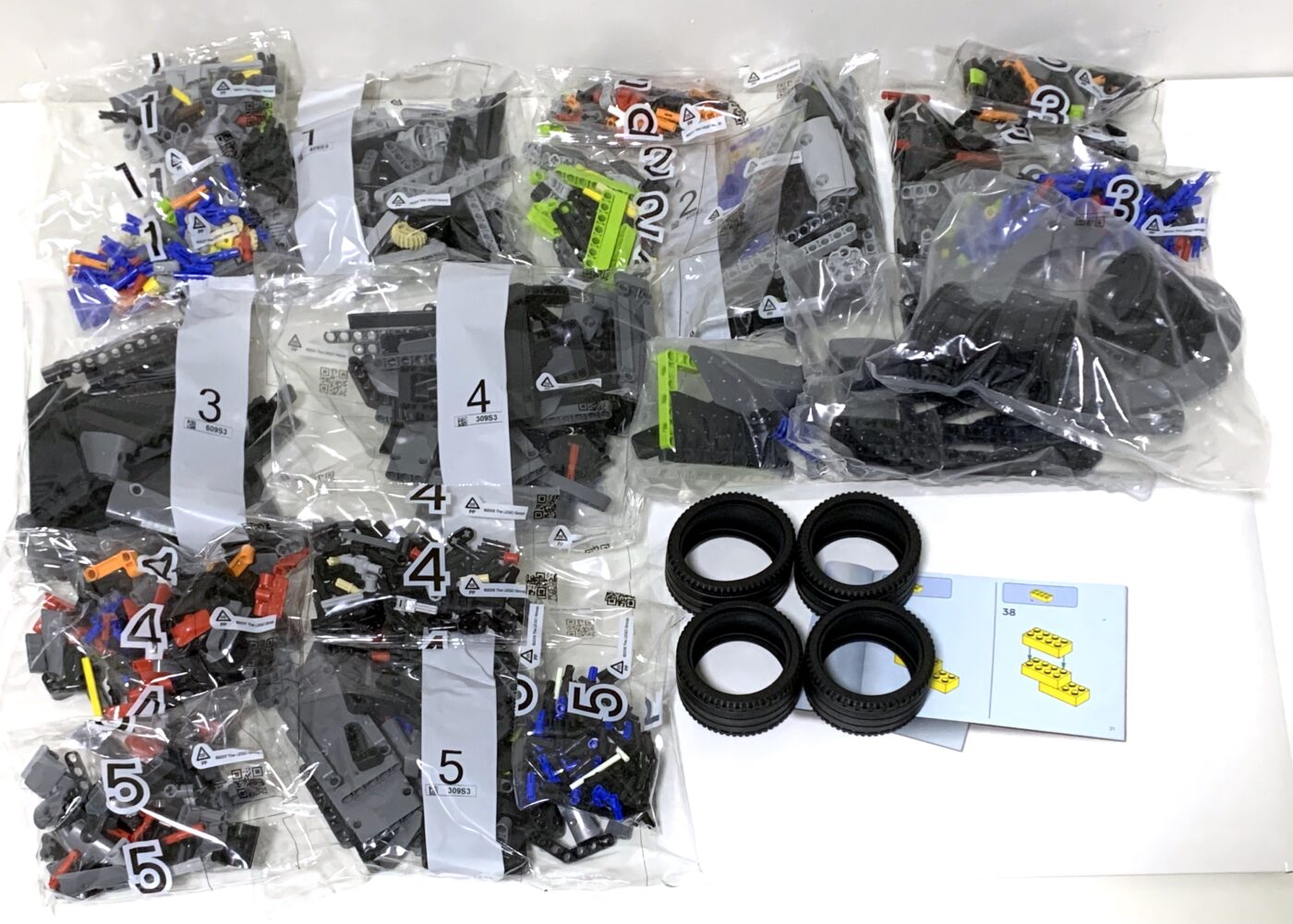
Inside the box you’ll find around 20 bags, split into 5 building stages. There are a few unnumbered bags that contain some of the larger pieces, and the four tyres come loose in the box.

Fortunately, the instruction manual and the sticker sheets (yes, there are 2 of them) come packaged inside this cardboard box for a much-needed layer of protection.
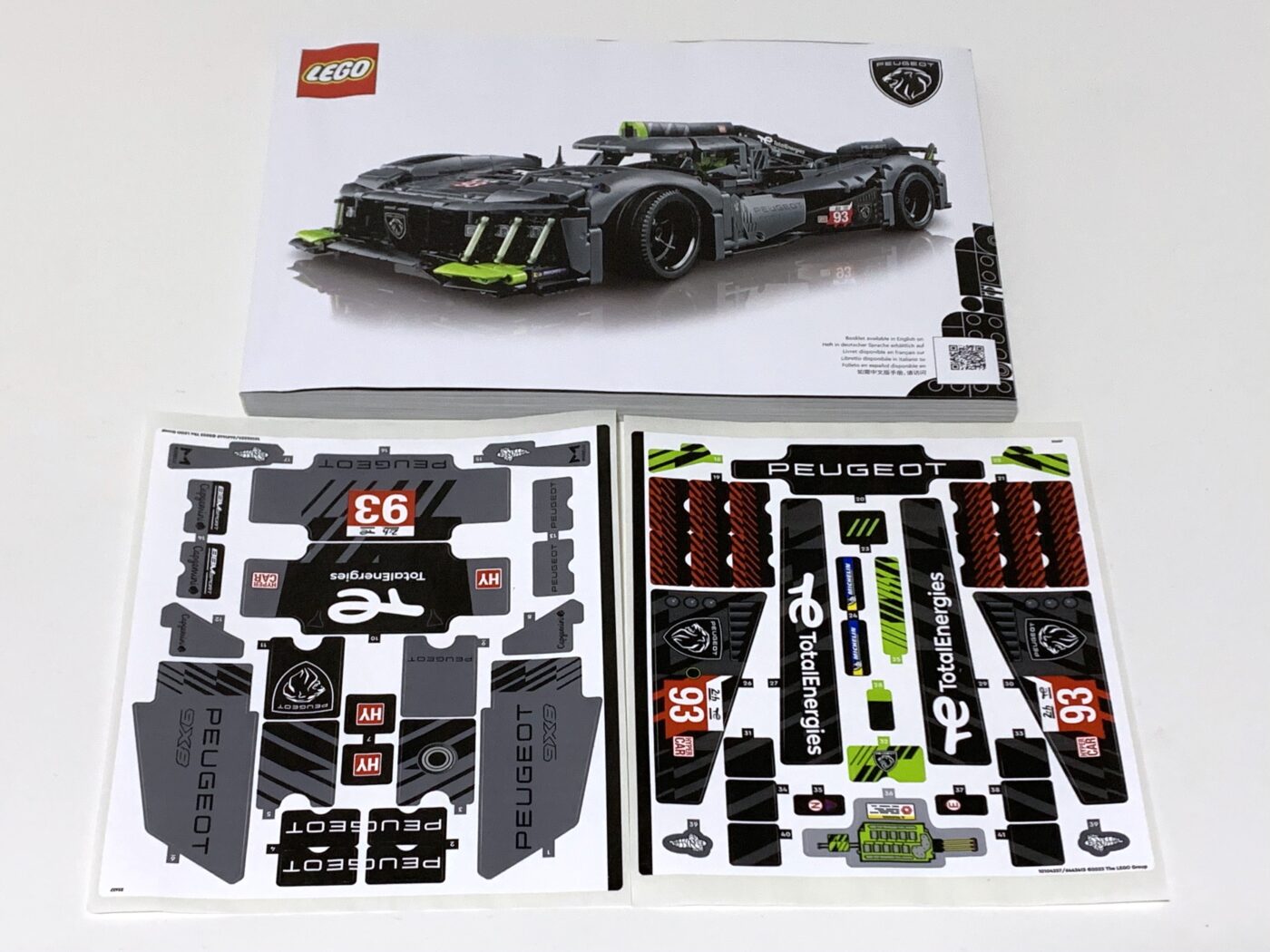
The instruction manual is a thick white book, and the two sticker sheets are really large – but that is to be expected, given the model is a racecar.
Surprisingly, it didn’t feel like a lot of stickers during the build process, as they’re fairly spread out.
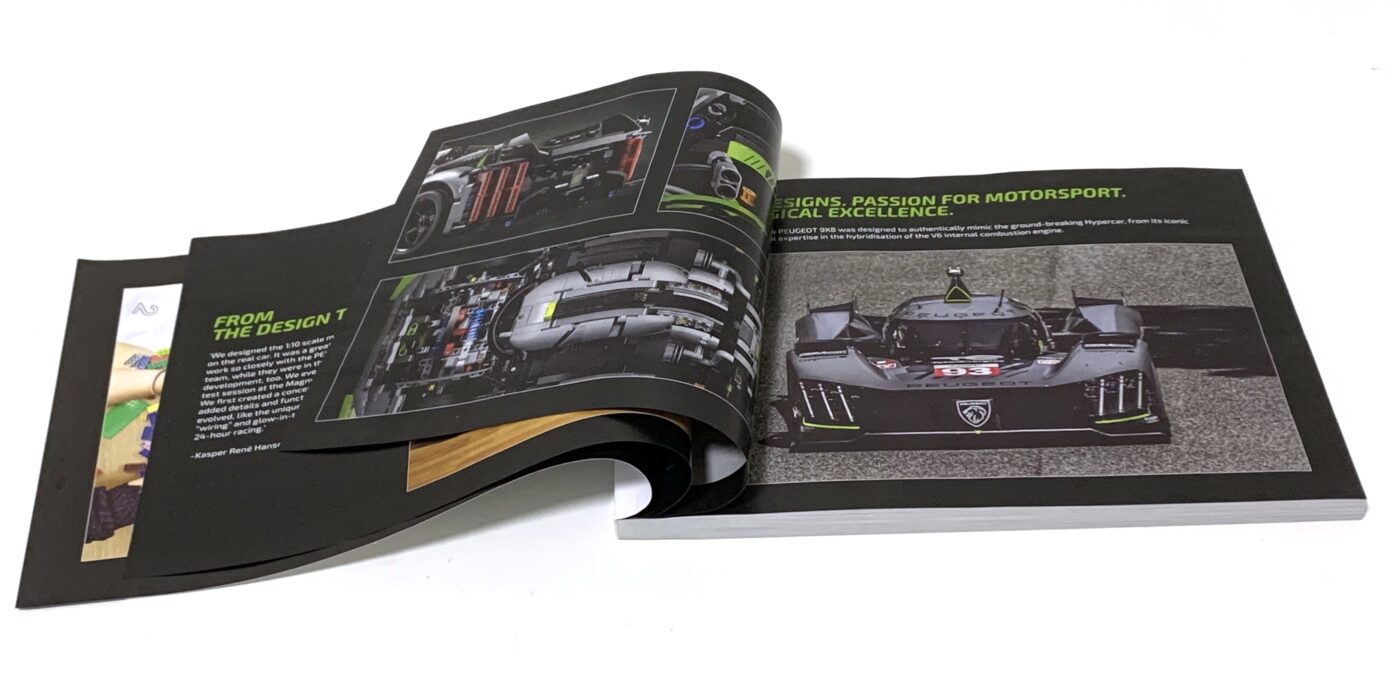
The manual has plenty of behind-the-scenes info about the real hypercar and the process of adapting it into a LEGO Technic model, which is nice to see.
It makes the model feel more premium than manuals that are light on background information and the story of how the set came to be.
Build Process

Bag 1 builds the main V6 engine, the rear differential with suspension, and all the foundation chassis work for the rear of the car.
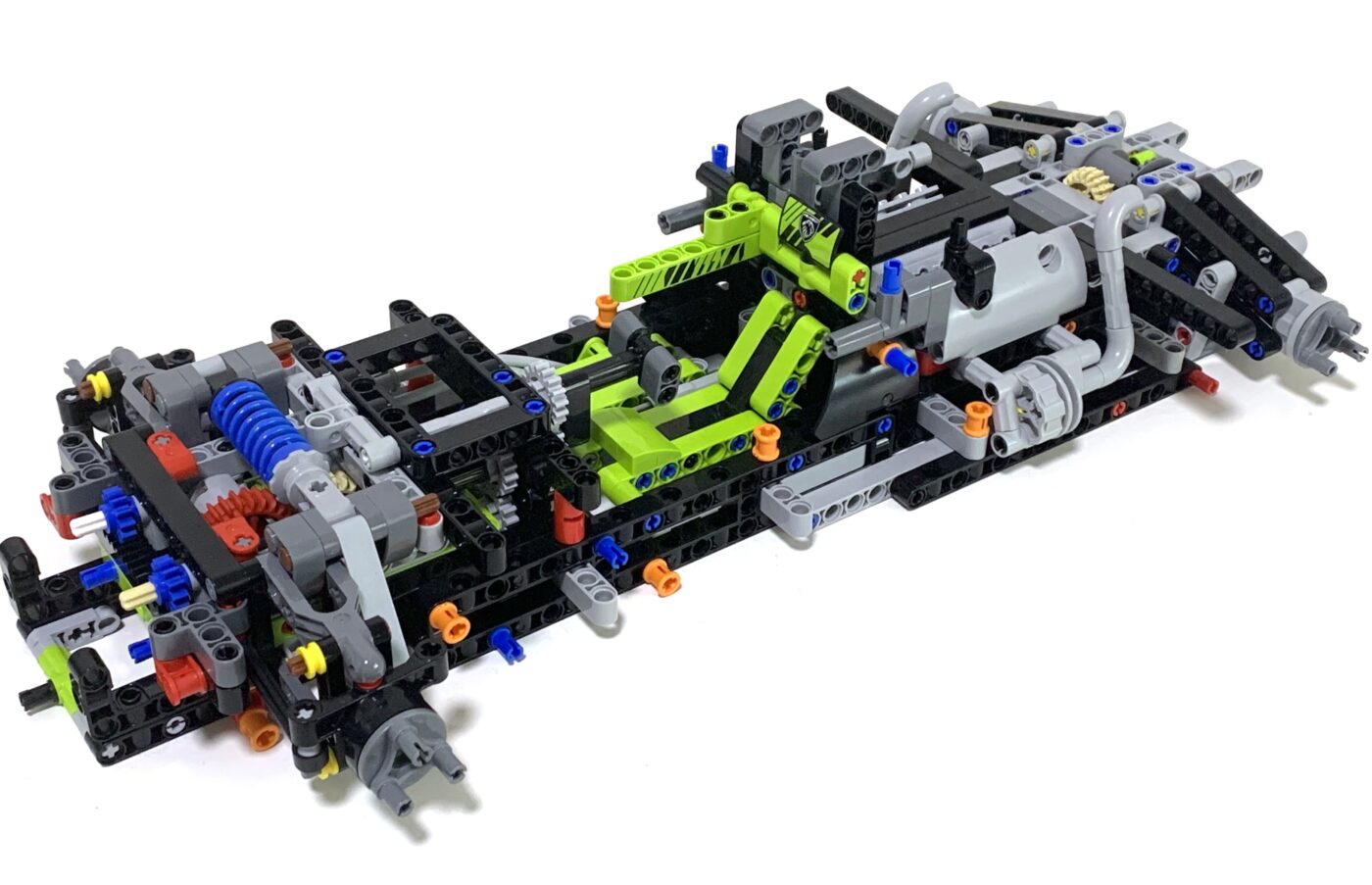
Bag 2 extends the chassis construction to the front, adding the front hybrid engine, driver’s seat, steering mechanism, and front suspension.
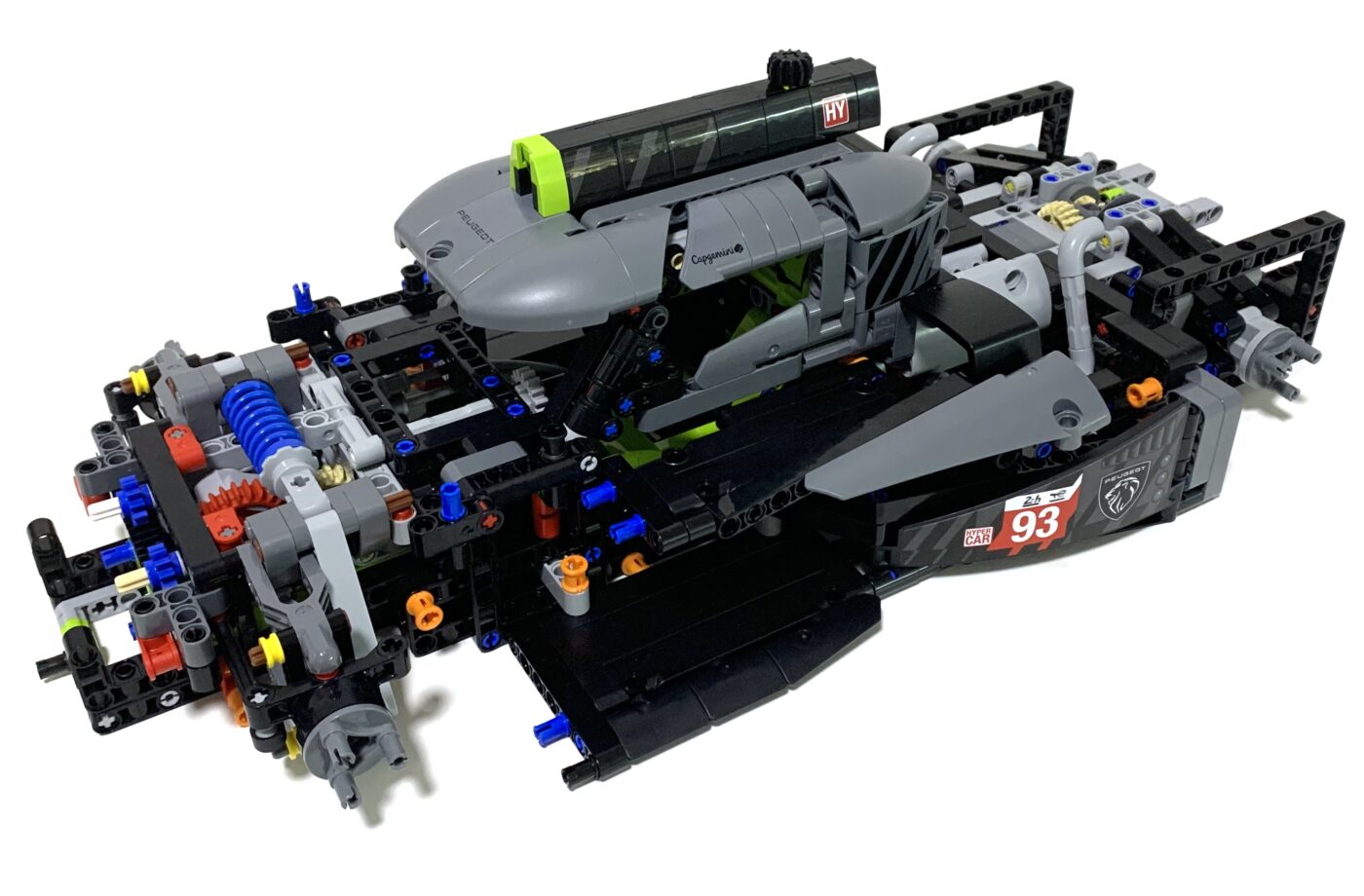
Bag 3 adds the paneling for the center bodywork, finishing up the steering mechanism and completing the driver’s compartment.

Bag 4 completes the paneling towards the rear, adding more stickers and some clever shaping.

Finally, bag 5 finishes up the model and adds the four wheels.
I built the model across several days, building one bag at a time. I will admit haven’t built many Technic sets, but this has to be one of my favorite set builds in recent memory.
It felt like I was constructing a real racecar, with clever mechanisms and functions sprinkled throughout followed by ingenious angles for the bodywork.
Comparison
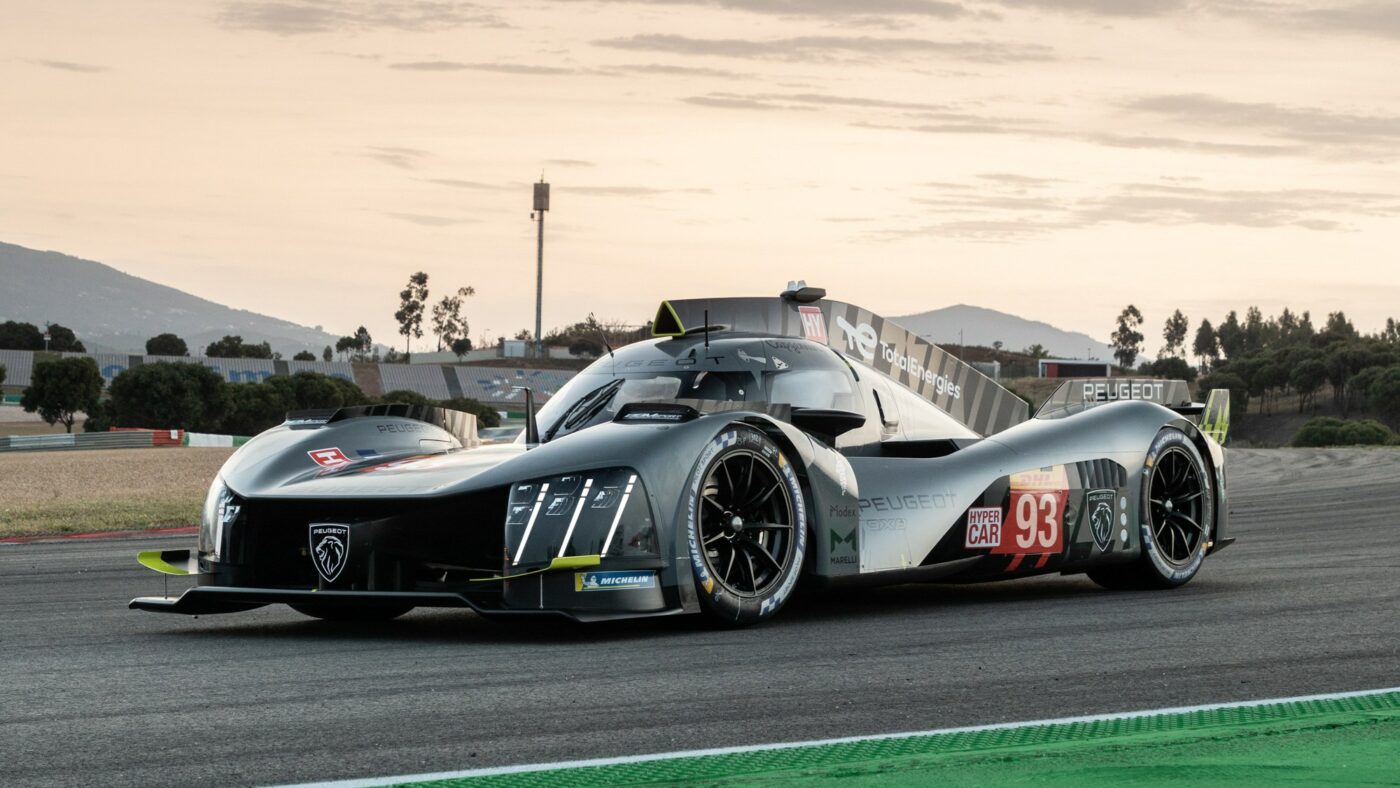
Here’s a picture of the real car for comparison, which has one of the more unique and unorthodox racecar designs, which works well in helping it stand out from other carmakers.
Completed Model
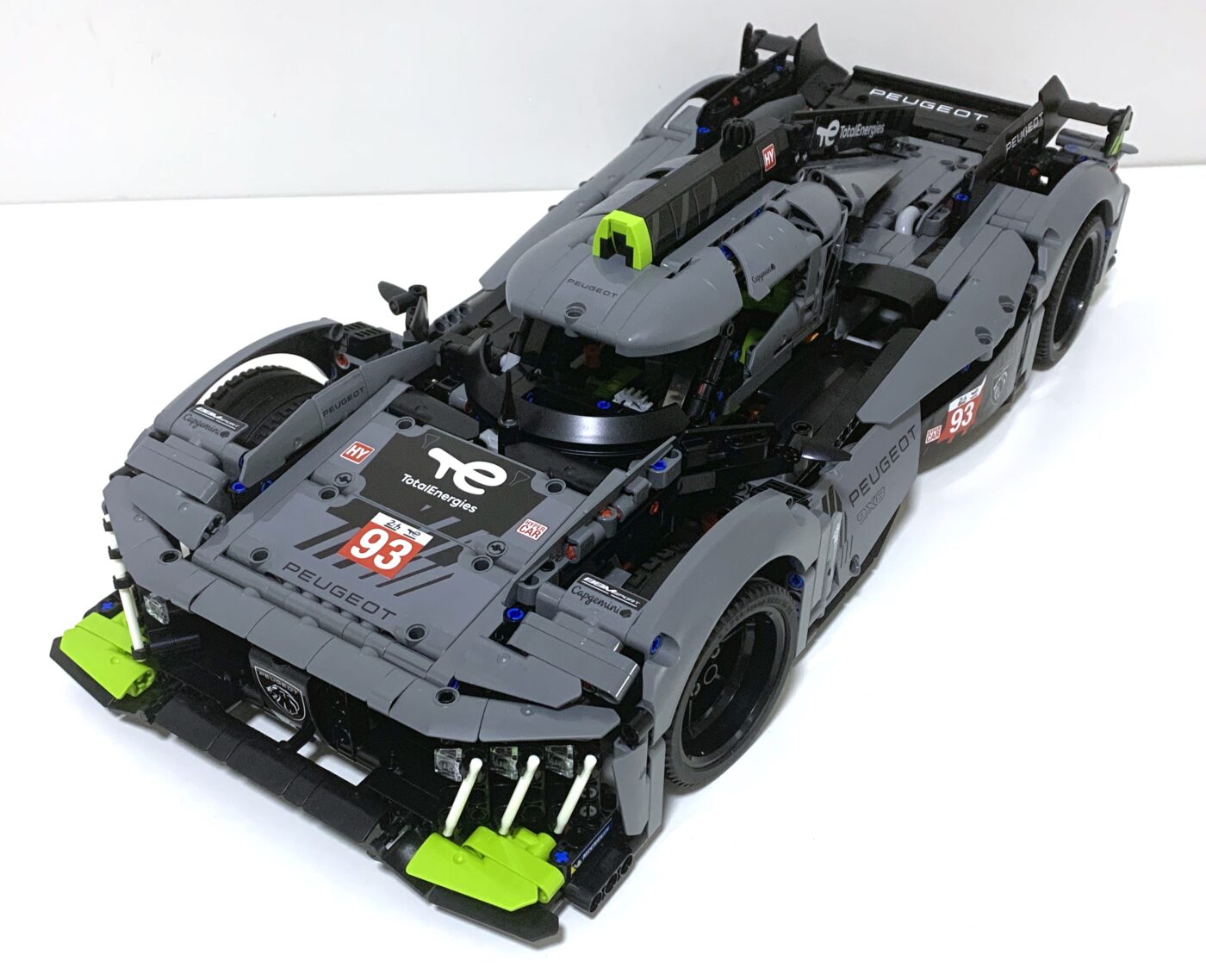
Here’s the completed model, which I must say looks really good for a Technic model. The curves and angles have been replicated well using Technic panels, and I like the lime green and black accents.
The dark grey colour scheme won’t be to everyone’s tastes – and it does look a little bit bland – but that’s due to the design of the source material.

The finished model is sizeable, measuring around 50 cm (or 20″) long. It also has decent heft to it; after all, it is made from over 1,700 pieces.

The most striking design element has to be the front, with the tiger claw light design that has become synonymous with this modern generation of Peugeot cars.
The modern Peugeot logo is present in the form of a sticker in the centre, and there’s some shaping using small Technic panels to replicate the front diffuser.
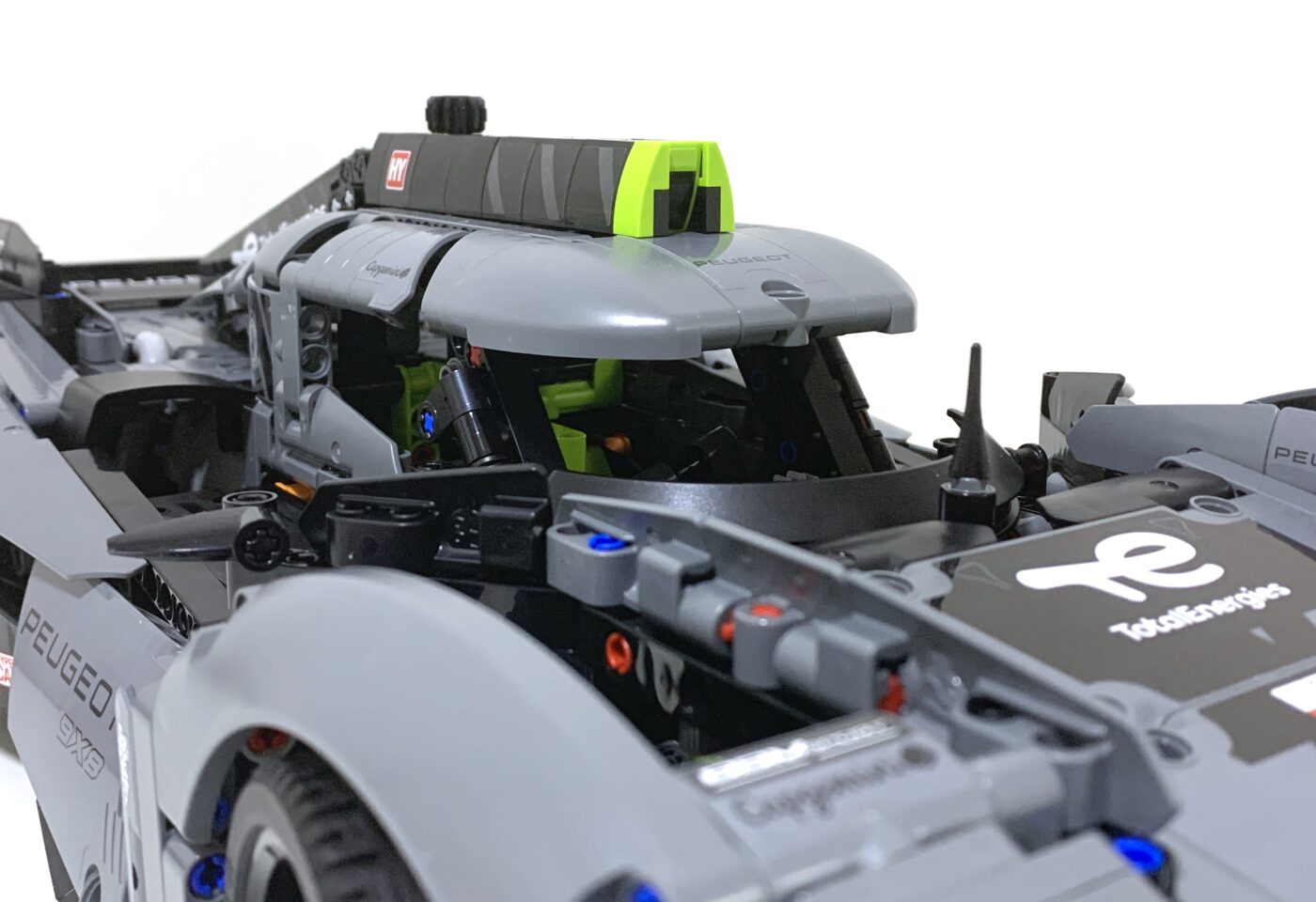
One divisive design choice is the lack of a windscreen element, with the designers opting for an open design – using curved pieces above and a black mudguard piece sideways below to simulate the bulbous shape of the driver’s section.
I personally feel it looks good enough, but some fans have expressed that this approach fails to capture the true round shape of the real car.

There’s this triangular shape on the top of the real Peugeot 9X8 that has been replicated here with curved slopes – it’s not exactly a triangle, but it’s pretty close by LEGO standards.

There are a pair of vents behind the cockpit that have been replicated seamlessly here. Even better, if you look through them you can actually see some of the engine detailing underneath the body panels!
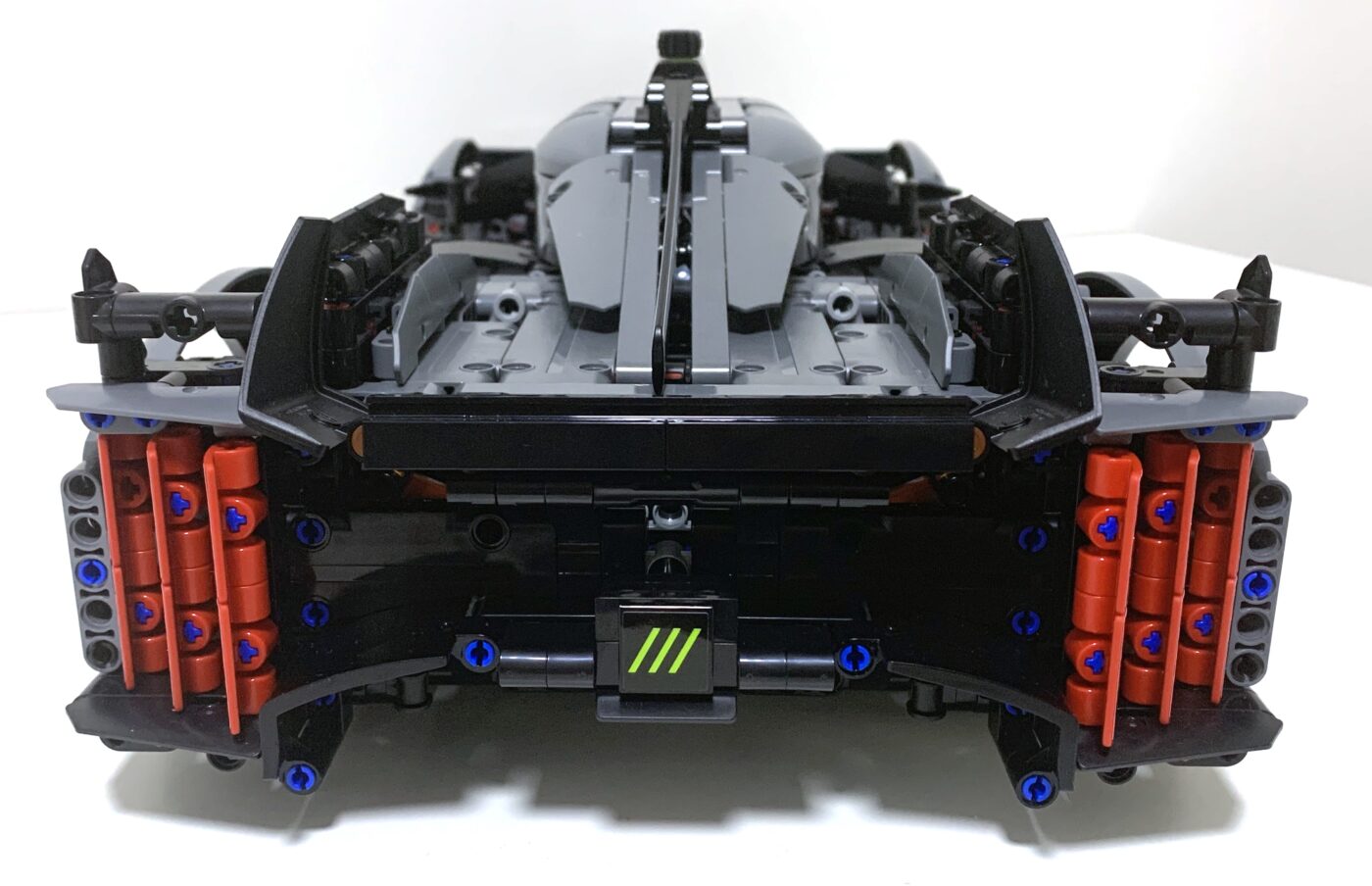
The rear of the car is also a very striking angle, with the linear tail lights and a large rear diffuser. However, the large number of visible blue pins is a little disruptive to the overall look.

The rear looks better from this 3/4 angle, where you can see the sticker design on the tail lights – 6 per section. Transparent red pieces would’ve definitely looked better, but red is good enough in terms of the overall design.
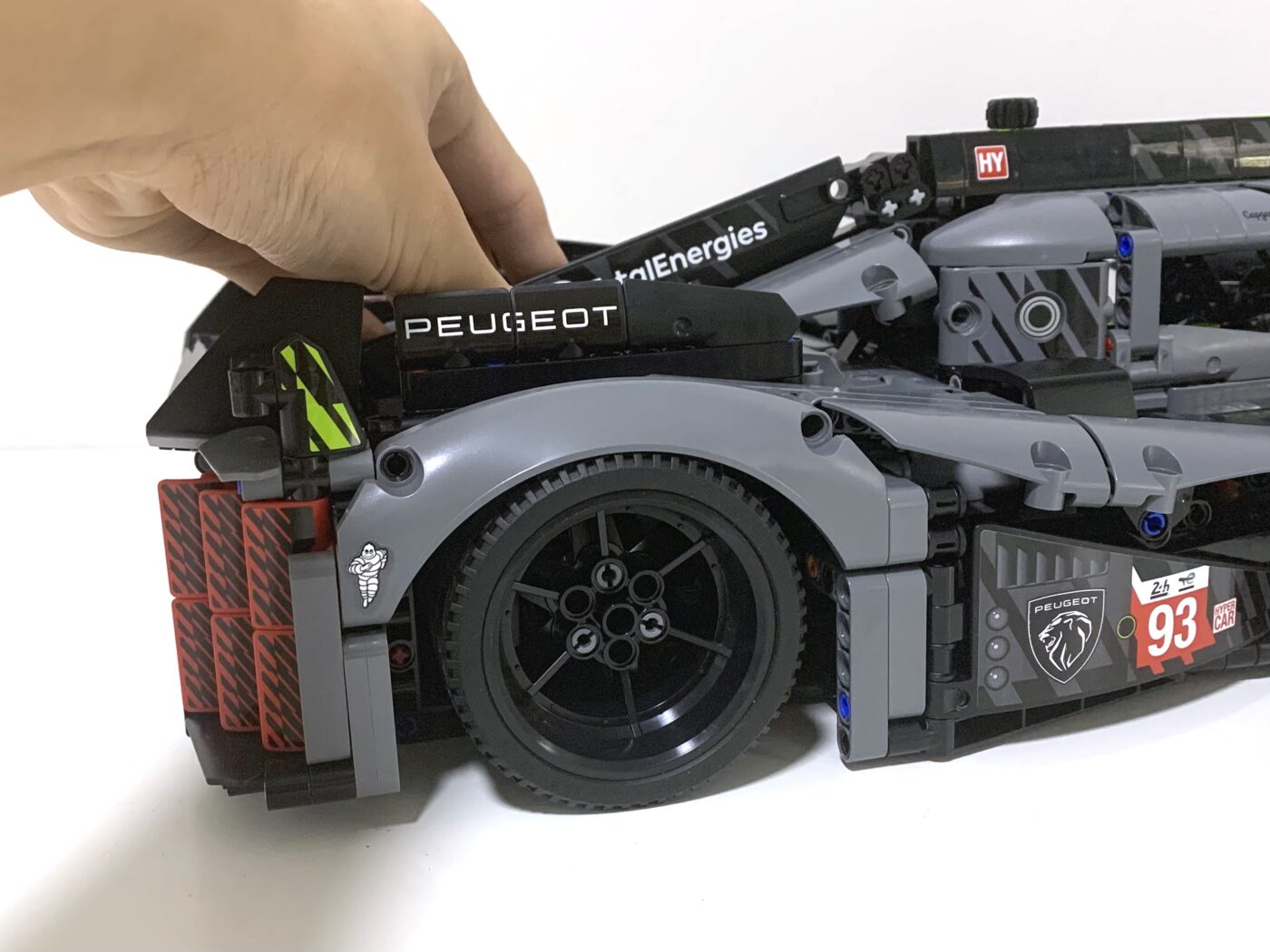
On to the functions, there’s independent suspension in all four wheels. It’s more noticeable in the rear wheels, as the front wheels don’t have much travel.

You can steer the front wheels. They are connected to both the steering wheel inside the cabin…

…and this hand-of-god steering knob above the cabin. It’s not super easy to turn as the knob is small and the tyres have a lot of friction, but it’s definitely doable.

The doors can open butterfly-style, although they don’t stay in place for too long.
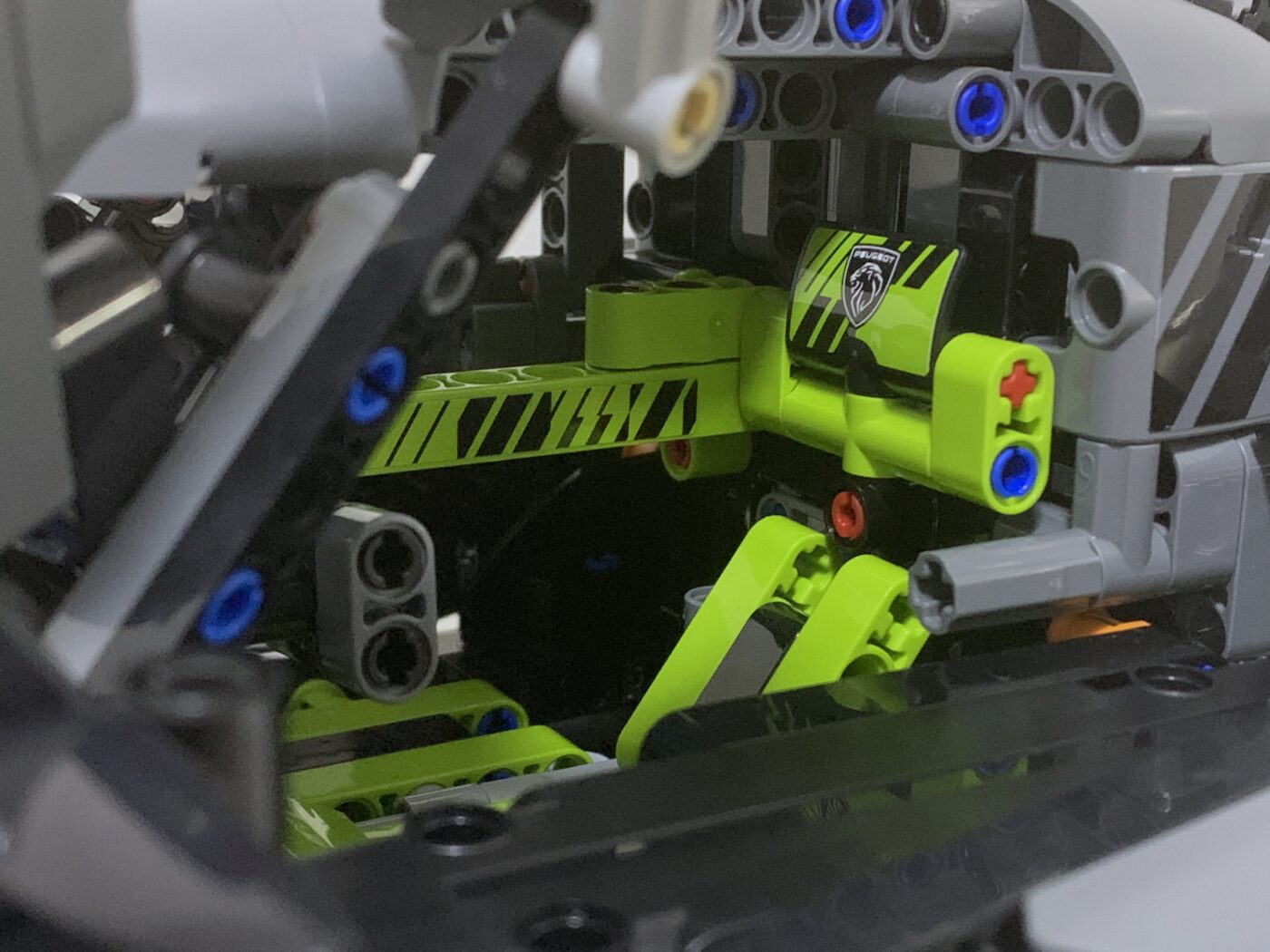
Inside you’ll find a lime green driver’s seat on the left side, with the Peugeot logo on the headrest.
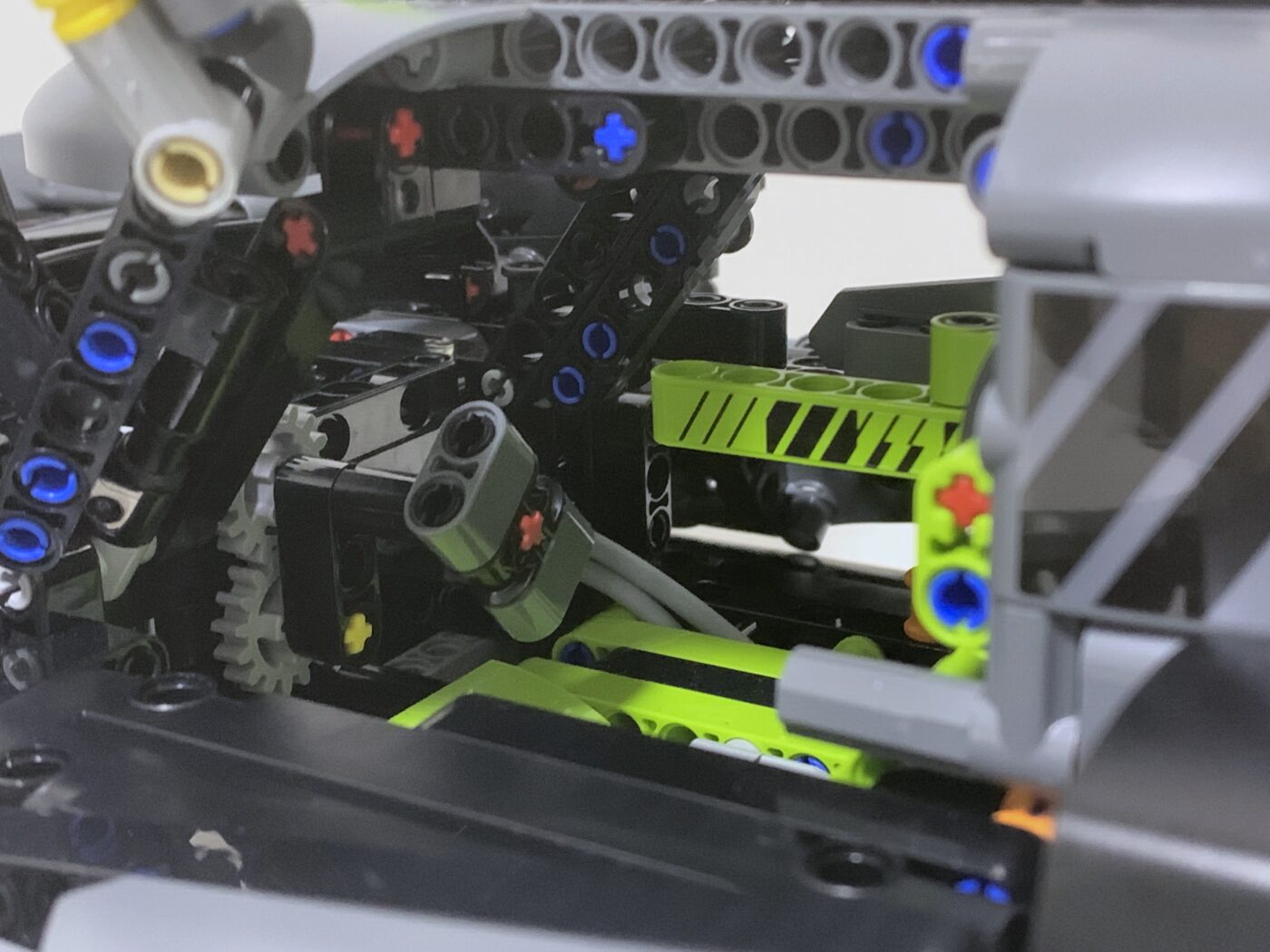
The steering yoke is rectangular, and turns with the front wheel. There’s also some flexible rubber bars on the other side of the interior to simulate the wires connected to the hybrid engine in front.

The front “bonnet” of the car can also open, to reveal some of the inner details.
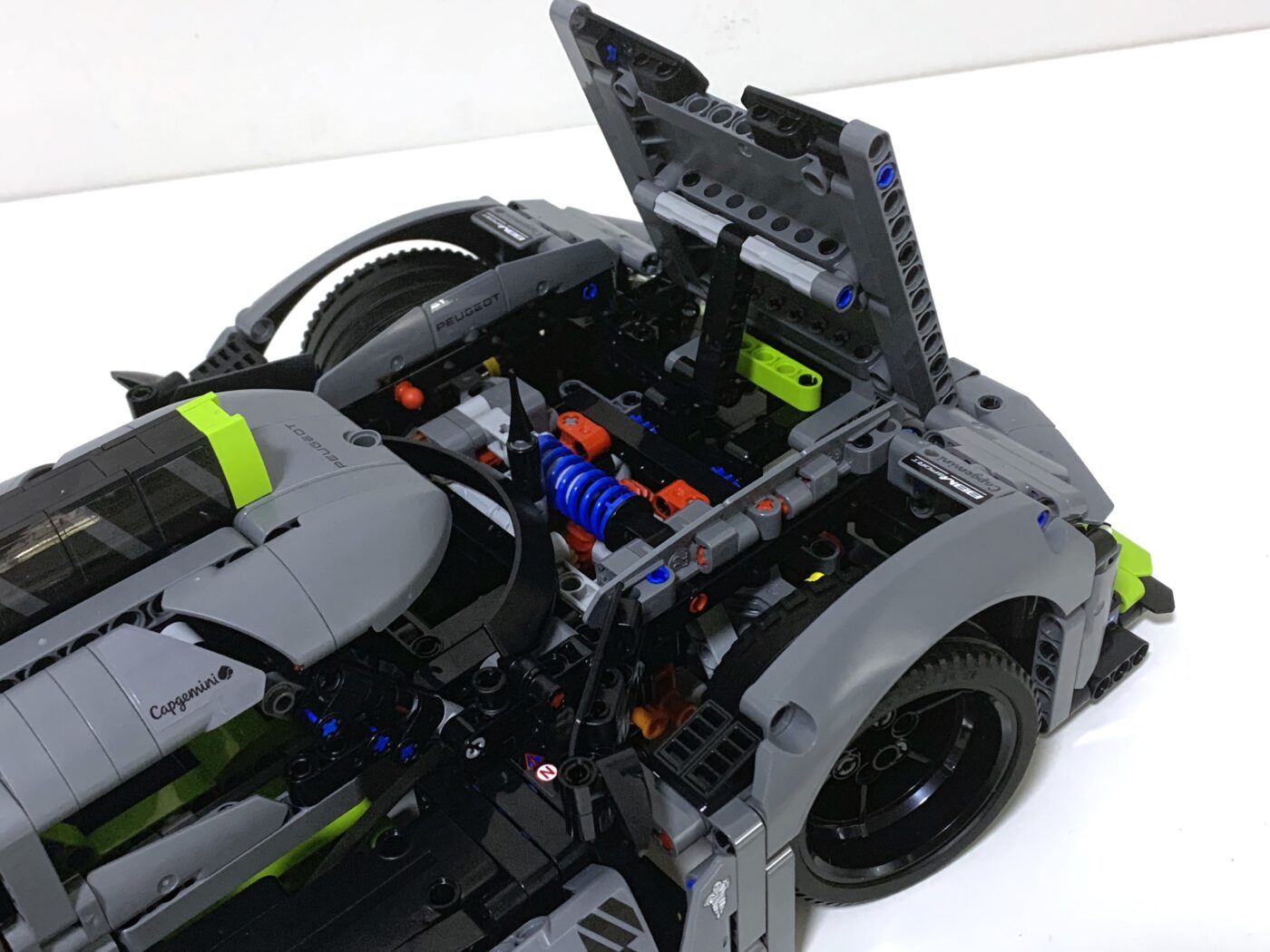
This gives you a closer look at the mechanical features, which were visible during the build process but covered up by the bodywork. You can see the large blue spring on top, which controls the suspension, along with a red gear attached to a differential for the front wheels.

You can also access the inner details at the rear, by picking up this section of the body panels…
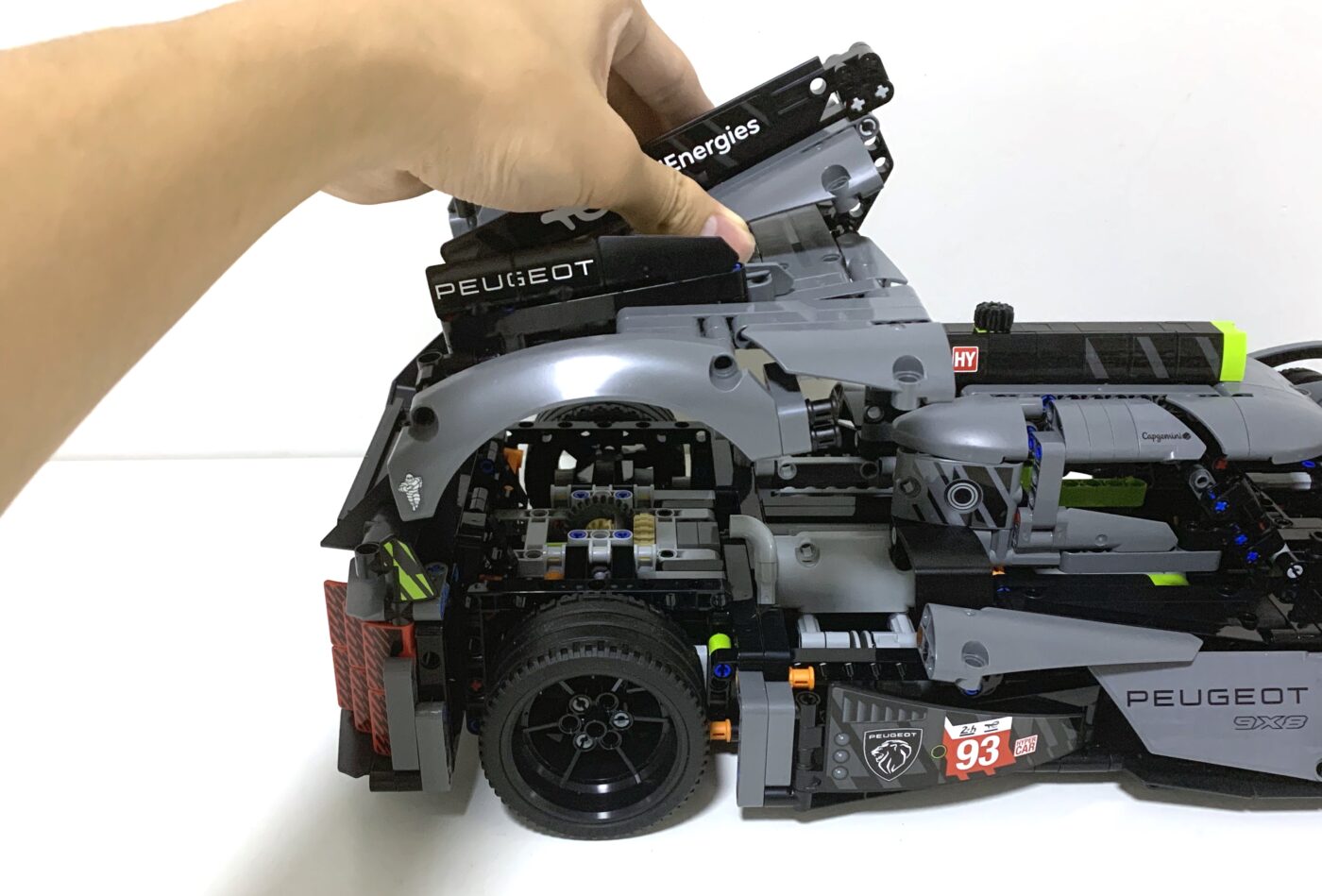
…and lifting it right off in one piece. It’s not actually attached firmly so it’ll fall off if you flip the car upside-down, but it’s more than secure enough for normal play.

Inside you can see the V6 engine connected to the rear differentials, which means the engine pumps away when you push the car forward. There’s no gearbox included at this scale, though.
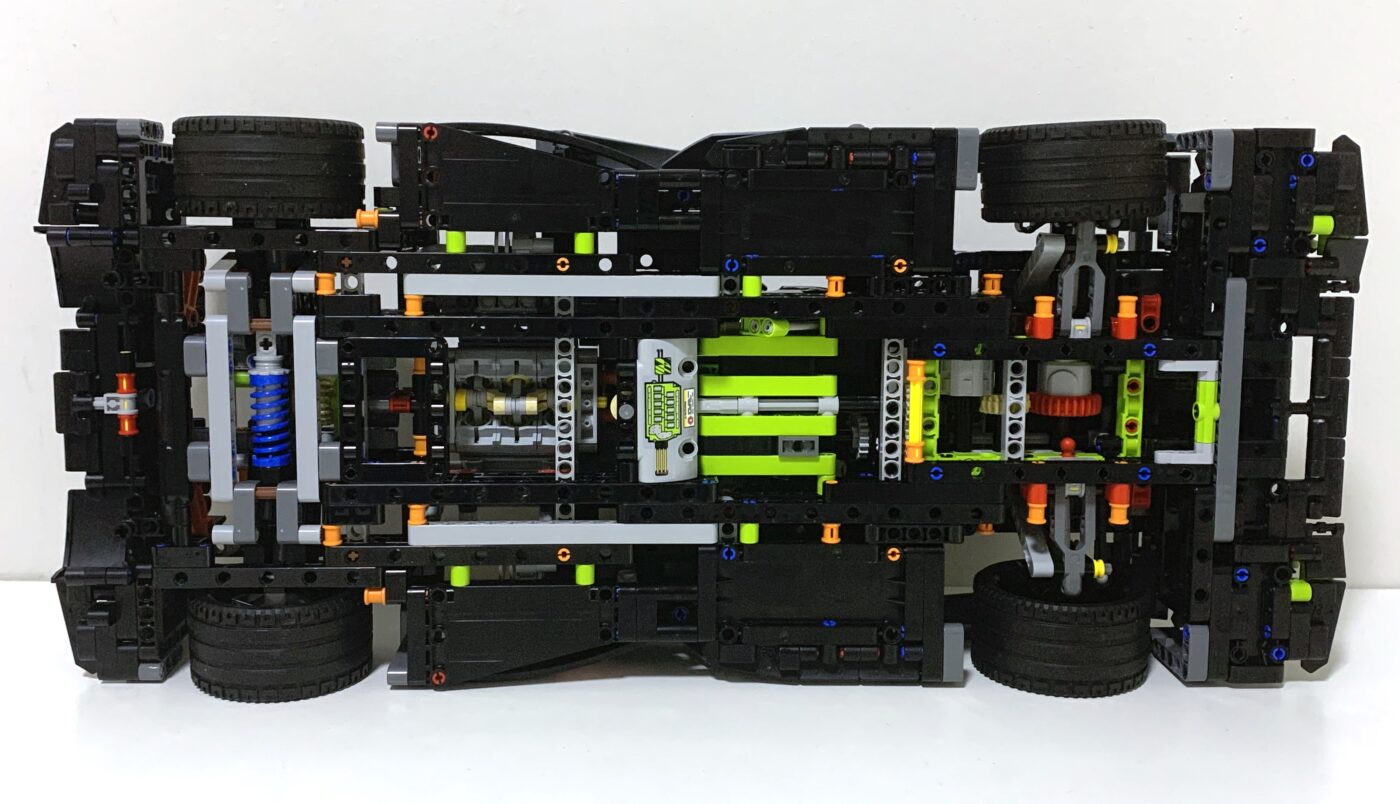
Additional details can be found on the underside of the car.
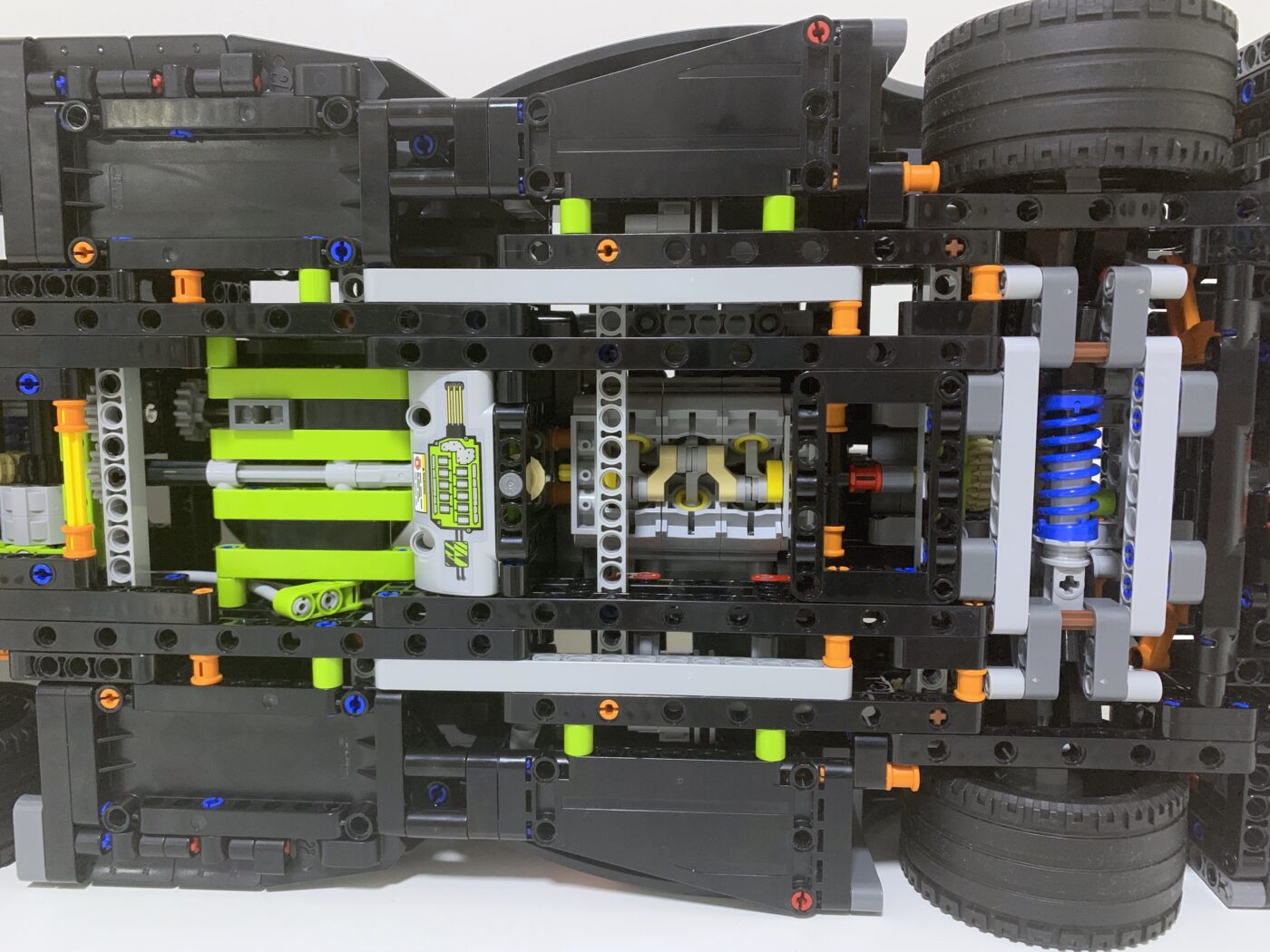
The rear half of the car has an interesting sticker with some cabling, along with a view of the bottom of the V6 engine and the rear suspension.
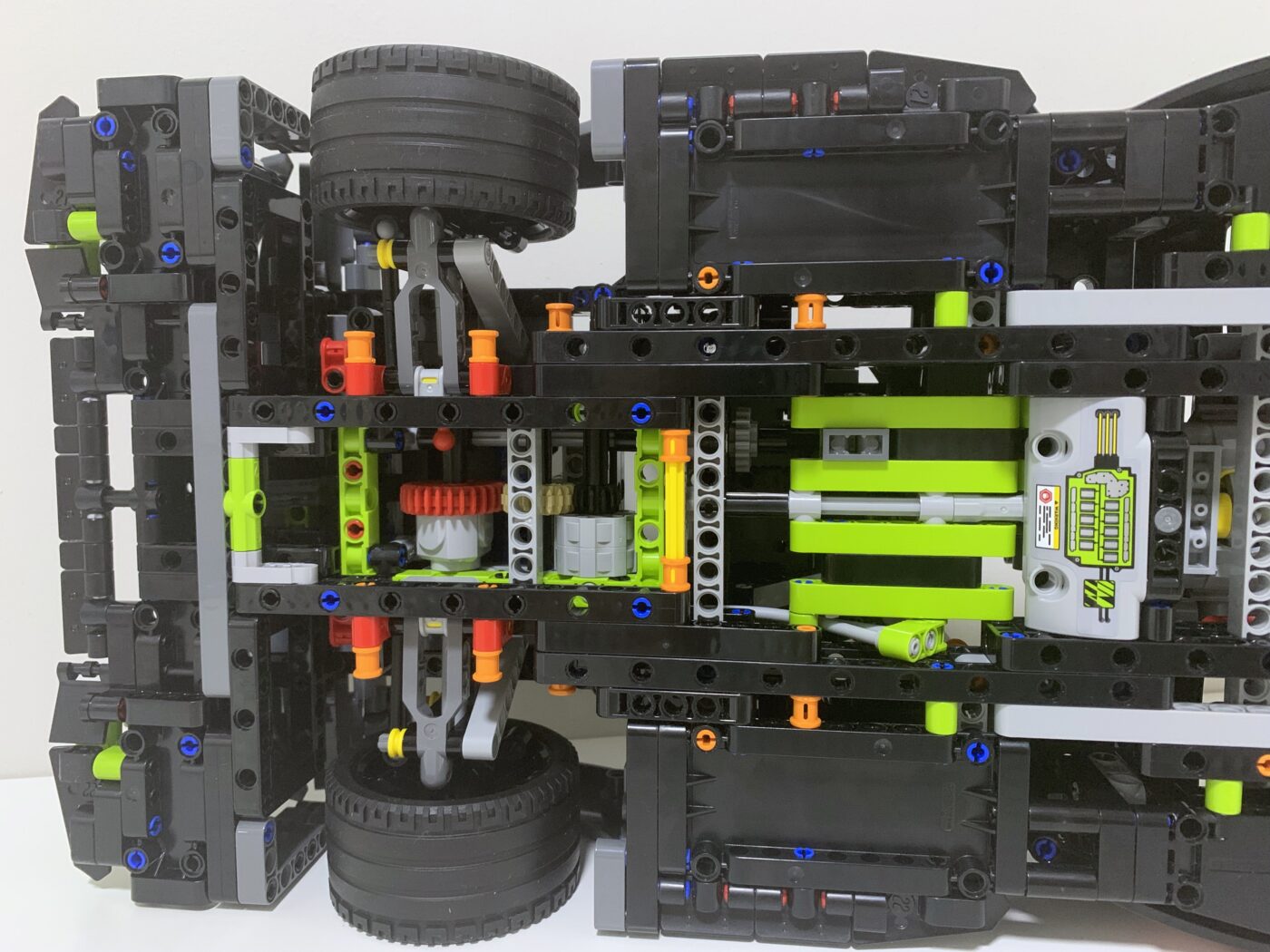
The front half shows a better look at the gears and differentials linked to the front wheels, along with the hybrid motor simulated by a pair of Technic weapon barrel elements. You can also see the central axle (between the lime green beams) that connects the steering mechanism to the hand-of-god steering knob.
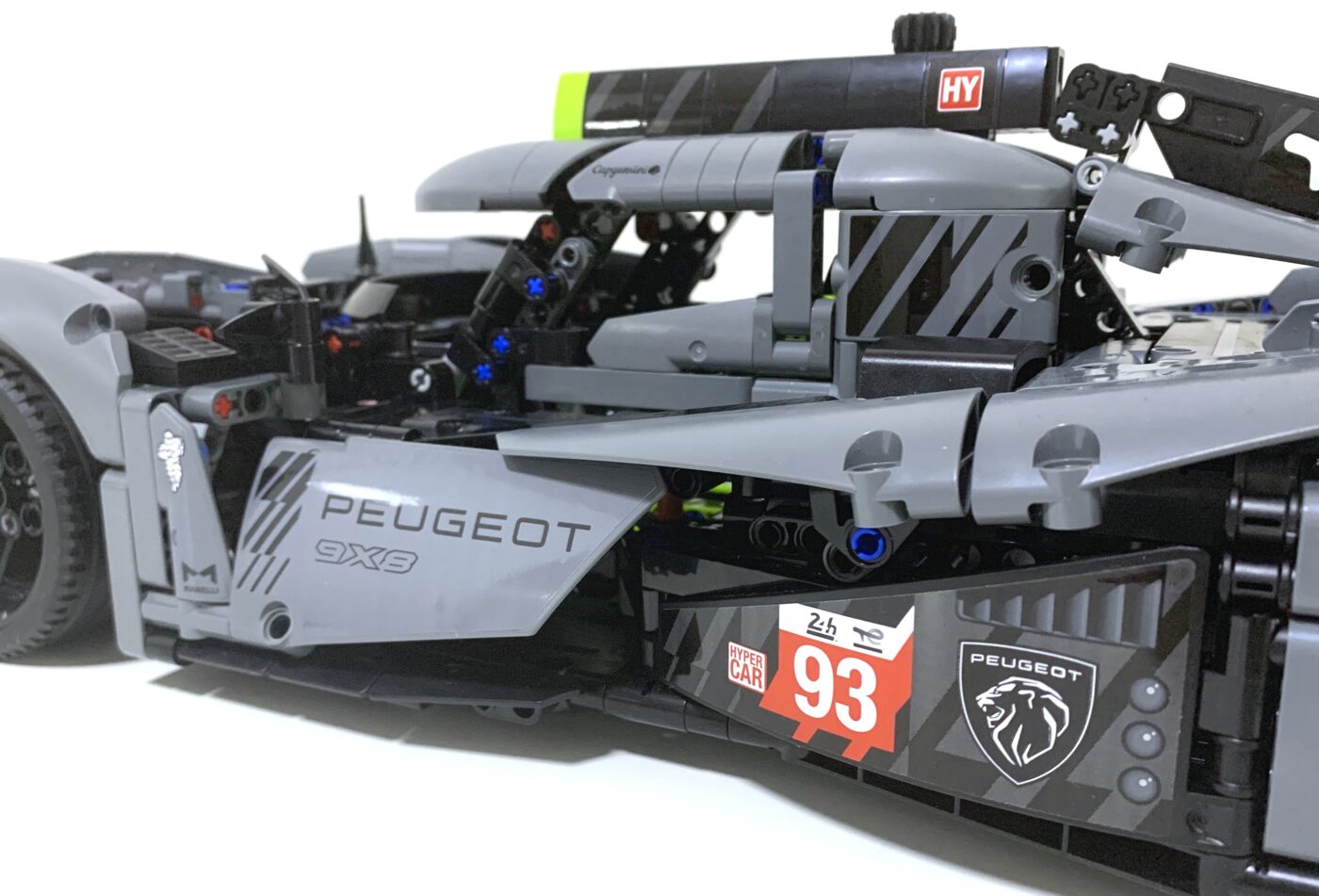
One thing I must commend the designers is their excellent job at using many existing Technic panel pieces to effectively recreate the shaping of the real Peugeot 9X8. Despite its tricky angles, the LEGO model looks very accurate to the real deal.
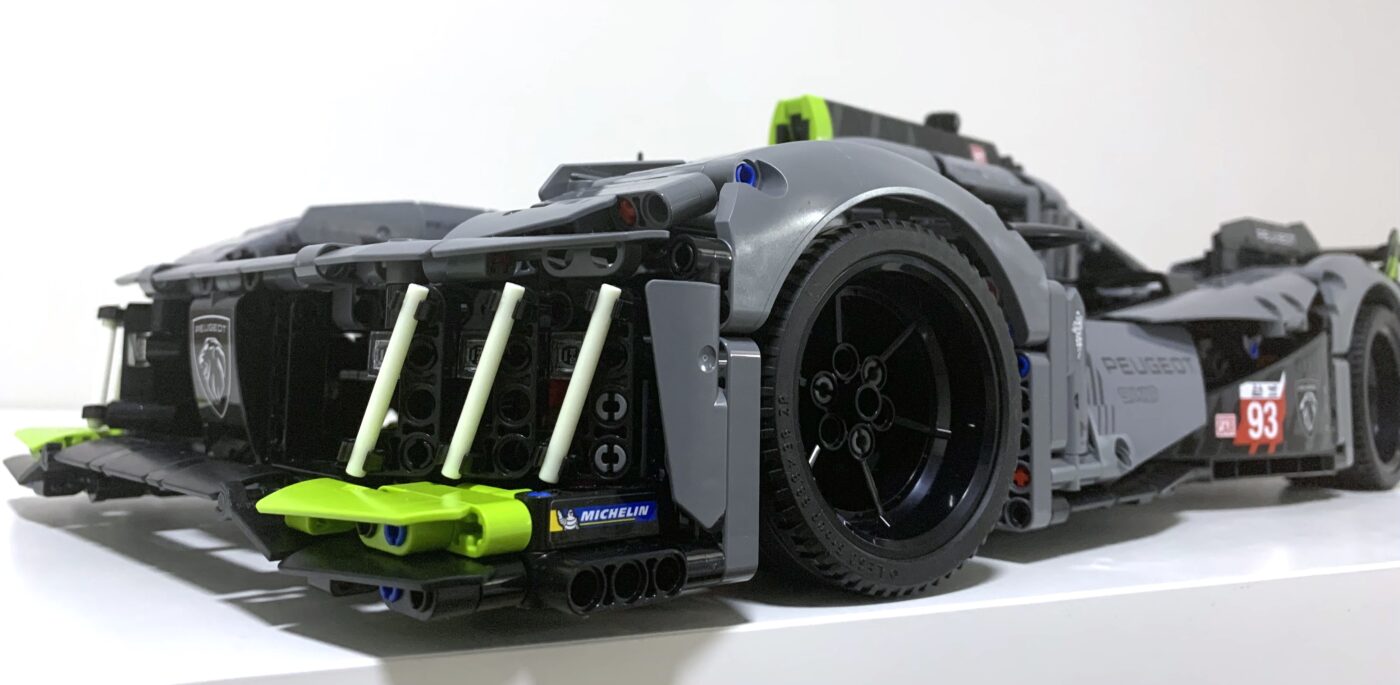
Also, despite the working suspension, it’s great to see that the gap between the underfloor and the ground is absolutely minimized.

Finally, there’s one play feature that adds a surprising amount of value to the model.

Put the model in a dark room, and the headlights will glow in the dark! This gives a very intimidating look, and is executed simply but brilliantly.
Final Thoughts
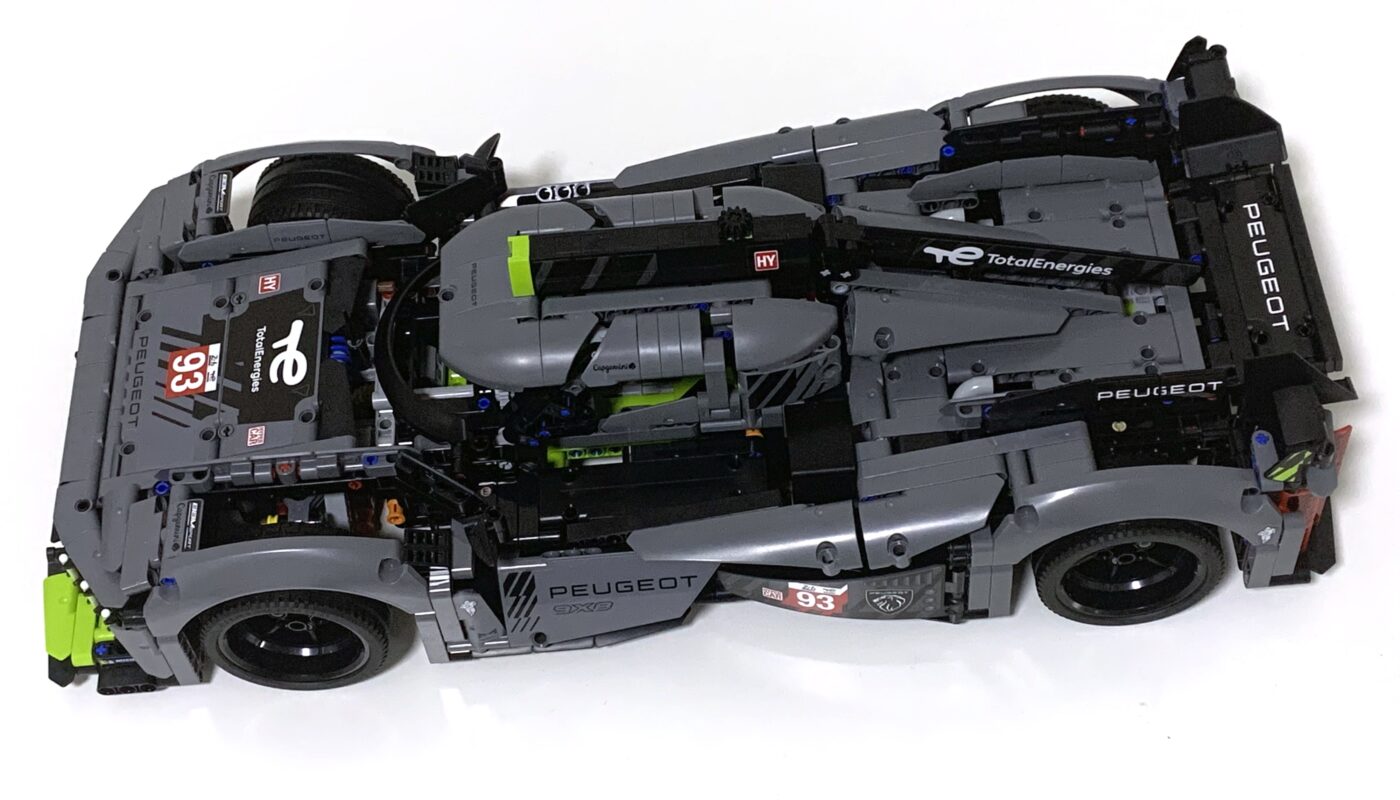
Final Thoughts: Overall, the LEGO Peugeot 9X8 is a really interesting model that will appeal to fans of LEGO vehicles and Technic fans.
Hardcore Technic fans may be disappointed by the lack of more complex mechanisms beyond the usual suspension, steering, and opening doors. While a gearbox would’ve been a brilliant inclusion, I personally enjoyed this set a lot, and I think there is a lot to love.
It’s not the most function-rich model, but it balances a healthy mix of all the essential functions with excellent bodywork shaping to create an aesthetically-pleasing model that will please racing fans.
It scores good points for display and play without significantly sacrificing either, although it admittedly does not excel in either area either. US$200 USD is also a high asking price, but if you have the budget you’ll be assured to get an engaging build process, a great-looking display model, and several enjoyable functions.
What I liked:
- Shaping of the car is great
- Final model looks very accurate, especially for a Technic set
- The included functions like the steering or the glow-in-the-dark headlights are fun
- Engaging build process
- Sizeable final model
What I didn’t like:
- Lacks more complex functionality that more hardcore Technic fans would expect (gearbox, etc.)
- Dark grey color scheme can be a bit dull
- No windscreen element
- Not overpriced, but not really cheap
Build [5] – An engaging build process from start to finish, and one that looks great when completed.
Playability [3] – The included functions are fun but I think some more complex functionality could’ve been included, especially considering the size of the model.
Real Value [4] – Decent value considering the size, functions, and accuracy of the final model.
Innovation [3] – Can’t say it’s innovative as licensed Technic cars are a dime a dozen nowadays, but this is definitely one of the better ones.
Keepability [4] – I didn’t think I would like it when it was revealed, but it has really grown on me – I think it’ll be sticking around.
Rating and Score: 4/5 ★★★★✰
Thanks for reading! 42156 Peugeot 9X8 24H LeMans Hybrid Hypercar is available online from LEGO.com, or your local LEGO store.
Want to read more LEGO vehicle reviews? Check out some of Vaderfan’s other LEGO Speed Champions reviews on the blog
- Review: 76918 McLaren Solus GT & McLaren F1 LM
- Review: 76914 Ferrari 812 Competizione
- Review: 76915 Pagani Utopia
- Review: 76917 2 Fast 2 Furious Nissan Skyline GT-R (R34)
- Review: LEGO 76907 Lotus Evija
To get the latest LEGO news and LEGO Reviews straight in your inbox, subscribe via email, or you can also follow on Google News, or socials on Facebook, Instagram (@jayong28), Twitter or subscribe to the Jay’s Brick Blog Youtube channel.







